Contents
- The climate of Kenai
- The best time to visit Kenai
- The worst time to visit Kenai
- Spring weather in Kenai
- Summer weather in Kenai
- Autumn weather in Kenai
- Winter weather in Kenai
- Weather in January
- Weather in February
- Weather in March
- Weather in April
- Weather in May
- Weather in June
- Weather in July
- Weather in August
- Weather in September
- Weather in October
- Weather in November
- Weather in December
- Frequently asked questions
- Average temperature
- Average pressure
- Average wind speed
- Average humidity
- Average rainfall
- Average rainfall days
- Average snowfall
- Average snowfall days
- Average sea temperature
- Average daylight
- Average sunshine
- Average sunshine days
- Average UV index
- Average cloud cover
- Average visibility
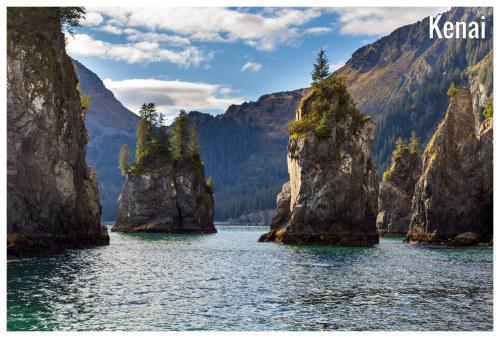
Climate and monthly weather forecast
The climate of Kenai
Annual weather changes in Kenai are significant. Temperatures swing between an average high of 61.3°F (16.3°C) in July to a chilly low of 18.3°F (-7.6°C) in January. Humidity levels generally remain between 69 to 87% throughout the year, contributing to the prevalent cool atmosphere.
Rainfall ranges from 0.91" (23mm) in June to 2.87" (73mm) in October, presenting a somewhat even spread of precipitation throughout the year. Snowfall, however, takes a prominent hold during winter, displaying peaks in February with 6.85" (174mm) and December with 8.74" (222mm). Sea temperatures follow a fairly predictable increase and decrease pattern, with maximum temperatures of 53.4°F (11.9°C) in August and minimum at 34.2°F (1.2°C) in February.
Interestingly, sunshine hours hike up to a high of 18.9 hours in June and dip to a low of 5.9 hours in December. The cloud cover remains fairly consistent year-round, contributing to Kenai's generally overcast conditions. The average visibility remains consistently at 6 miles, notwithstanding the climatological shifts amid different seasons.
The best time to visit Kenai
The worst time to visit Kenai
Spring weather in Kenai
Summer weather in Kenai
Autumn weather in Kenai
Winter weather in Kenai
Weather in January
Weather in February
Weather in March
Weather in April
Weather in May
Weather in June
Weather in July
Weather in August
Weather in September
Weather in October
Weather in November
Weather in December
Published by: Weather U.S. | About Us
Data Sources | Weather Forecasting & Climate
Frequently asked questions
What time of the year is the coldest?
What is the most humid month?
How many days does it rain?
When does it snow?
How many days does it snow?
When is the lowest UV index?
When is the ocean coldest?
When is Daylight Saving Time (DST)?
What is the least humid month in Kenai?
When it does not snow?
What is the driest month?
When are the longest days?
What month has the most sunshine?
What are the months with the highest UV index?
What part of the year is the hottest?
What is the month with the warmest ocean?
What is the wettest month?
When does it snow the most?
What is the month with the shortest days?
What is the month with the least sunshine?
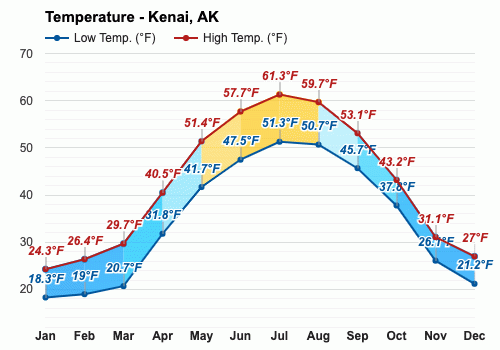
Average temperature
Kenai, AK
The warmest month (with the highest average high temperature) is July (61.3°F).
The month with the lowest average high temperature is January (24.3°F).
The month with the highest average low temperature is July (51.3°F).
The coldest month (with the lowest average low temperature) is January (18.3°F).
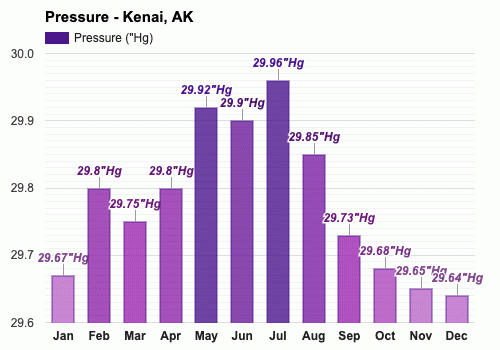
Average pressure
Kenai, AK
- Average pressure in January:
29.67"Hg - Average pressure in February:
29.8"Hg - Average pressure in March:
29.75"Hg - Average pressure in April:
29.8"Hg - Average pressure in May:
29.92"Hg - Average pressure in June:
29.9"Hg
- Average pressure in July:
29.96"Hg - Average pressure in August:
29.85"Hg - Average pressure in September:
29.73"Hg - Average pressure in October:
29.68"Hg - Average pressure in November:
29.65"Hg - Average pressure in December:
29.64"Hg
The month with the highest atmospheric pressure is July (29.96"Hg).
The month with the lowest atmospheric pressure is December (29.64"Hg).
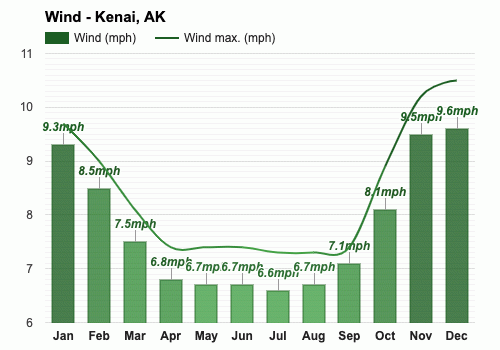
Average wind speed
Kenai, AK
- Average wind speed in January:
9.3mph - Average wind speed in February:
8.5mph - Average wind speed in March:
7.5mph - Average wind speed in April:
6.8mph - Average wind speed in May:
6.7mph - Average wind speed in June:
6.7mph
- Average wind speed in July:
6.6mph - Average wind speed in August:
6.7mph - Average wind speed in September:
7.1mph - Average wind speed in October:
8.1mph - Average wind speed in November:
9.5mph - Average wind speed in December:
9.6mph
The windiest month (with the highest average wind speed) is December (9.6mph).
The calmest month (with the lowest average wind speed) is July (6.6mph).

Average humidity
Kenai, AK
The months with the highest relative humidity are January and February (87%).
The month with the lowest relative humidity is May (69%).

Average rainfall
Kenai, AK
- Average rainfall in January:
1.26" - Average rainfall in February:
1.26" - Average rainfall in March:
1.02" - Average rainfall in April:
1.26" - Average rainfall in May:
1.06" - Average rainfall in June:
0.91"
- Average rainfall in July:
1.42" - Average rainfall in August:
2.01" - Average rainfall in September:
2.72" - Average rainfall in October:
2.87" - Average rainfall in November:
1.77" - Average rainfall in December:
1.93"
The wettest month (with the highest rainfall) is October (2.87").
The driest month (with the least rainfall) is June (0.91").

Average rainfall days
Kenai, AK
- Average rainfall days in January:
8.7 days - Average rainfall days in February:
5.5 days - Average rainfall days in March:
7.6 days - Average rainfall days in April:
12.8 days - Average rainfall days in May:
13.2 days - Average rainfall days in June:
11.6 days
- Average rainfall days in July:
12.8 days - Average rainfall days in August:
15.8 days - Average rainfall days in September:
16.6 days - Average rainfall days in October:
15.6 days - Average rainfall days in November:
9 days - Average rainfall days in December:
7.1 days
The month with the highest number of rainy days is September (16.6 days).
The month with the least rainy days is February (5.5 days).
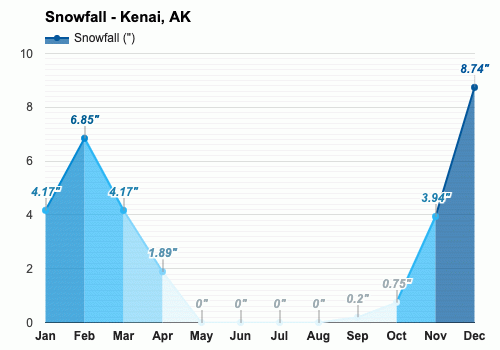
Average snowfall
Kenai, AK
The month with the highest snowfall is December (8.74").
The months with the least snowfall are May, June, July and August (0").

Average snowfall days
Kenai, AK
- Average snowfall days in January:
11 days - Average snowfall days in February:
11.8 days - Average snowfall days in March:
10.2 days - Average snowfall days in April:
5.7 days - Average snowfall days in May:
0.2 days - Average snowfall days in June:
0 days
- Average snowfall days in July:
0 days - Average snowfall days in August:
0 days - Average snowfall days in September:
0.3 days - Average snowfall days in October:
1.5 days - Average snowfall days in November:
8.7 days - Average snowfall days in December:
12.7 days
The month with the highest number of snowfall days is December (12.7 days).
The months with the least snowfall days are June, July and August (0 days).

Average sea temperature
Kenai, AK
The best month for swimming (with the highest average sea temperature) is August (53.4°F).
The coldest month (with the lowest average sea temperature) is February (34.2°F).
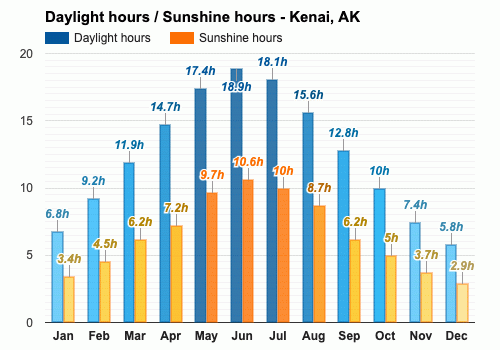
Average daylight / Average sunshine
Kenai, AK
- Average daylight in January:
6h and 5min - Average daylight in February:
9h and 1min - Average daylight in March:
11h and 5min - Average daylight in April:
14h and 4min - Average daylight in May:
17h and 2min - Average daylight in June:
18h and 5min
- Average daylight in July:
18h and 1min - Average daylight in August:
15h and 4min - Average daylight in September:
12h and 5min - Average daylight in October:
10h and 0min - Average daylight in November:
7h and 2min - Average daylight in December:
5h and 5min
The month with the longest days is June (Average daylight: 18h and 54min).
The month with the shortest days is December (Average daylight: 5h and 54min).
- Average sunshine in January:
3h and 2min - Average sunshine in February:
4h and 3min - Average sunshine in March:
6h and 1min - Average sunshine in April:
7h and 1min - Average sunshine in May:
9h and 4min - Average sunshine in June:
10h and 4min
- Average sunshine in July:
10h and 0min - Average sunshine in August:
8h and 4min - Average sunshine in September:
6h and 1min - Average sunshine in October:
5h and 0min - Average sunshine in November:
3h and 4min - Average sunshine in December:
2h and 5min
The month with the most sunshine is June (Average sunshine: 10h and 36min).
The month with the least sunshine is December (Average sunshine: 2h and 54min).
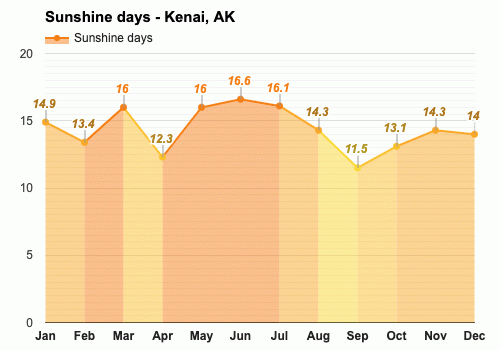
Average sunshine days
Kenai, AK
- Average sunshine days in January:
14.9 days - Average sunshine days in February:
13.4 days - Average sunshine days in March:
16 days - Average sunshine days in April:
12.3 days - Average sunshine days in May:
16 days - Average sunshine days in June:
16.6 days
- Average sunshine days in July:
16.1 days - Average sunshine days in August:
14.3 days - Average sunshine days in September:
11.5 days - Average sunshine days in October:
13.1 days - Average sunshine days in November:
14.3 days - Average sunshine days in December:
14 days
The month with the most sunshine days is June (16.6 days).
The month with the least sunshine days is September (11.5 days).

Average UV index
Kenai, AK
The months with the highest UV index are June and July (UV index 4).
The month with the lowest UV index is January (UV index 1).

Average cloud cover
Kenai, AK
The month with the most cloud cover is December (Cloud cover 58).
The month with the least cloud cover is June (Cloud cover 44).

Average visibility
Kenai, AK
The months with the highest visibility are January, March, April, May, June, July, August, September, October, November and December (6mi).
The month with the lowest visibility is February (5mi).